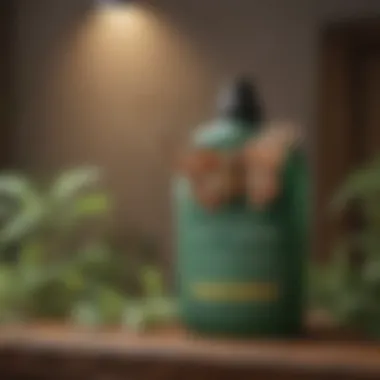Natural Solutions to Get Rid of House Moths


Intro
House moths, specifically textile and pantry moths, are unwelcome guests in many homes. These insects can damage clothing, fabrics, and stored food. Therefore, seeking natural methods to eliminate them is crucial. This article aims to offer insights into recognizing these pests and employing eco-friendly strategies for their removal. Homeowners, gardening aficionados, and interior design enthusiasts will find actionable advice throughout the text.
Understanding Moths
Before tackling moth problems, it is essential to understand their biology and behavior. Moths typically go through four life stages: egg, larva, pupa, and adult. The larval stage is the most destructive. Both the larvae and adult moths feed on organic materials such as wool, silk, and grains. Recognizing the signs of an infestation is vital. Look for webbing, frass (excrement), and damaged items.
Prevention Strategies
Natural Repellents
Utilizing natural repellents can significantly deter moths from entering your home. Certain aromas repel moths effectively. Consider using essential oils like lavender, cedar, and eucalyptus. These scents can be applied to cotton balls and placed in closets or drawers.
- Lavender: Acts as a natural deterrent and adds a pleasant scent.
- Cedar: The wood contains compounds that repel moths; cedar blocks can be placed in storage.
- Eucalyptus: Similarly, effective as an insect repellent.
Proper Storage
Properly storing clothing and food items can eliminate attracting moths. Here are some tips:
- Clean clothing and textiles before storage.
- Use airtight containers for food items.
- Regularly inspect and clean storage areas.
Practical Solutions
Traps
Homemade traps can reduce moth populations effectively. A simple mix of soap and water can catch adult moths. Sprinkle soap in a bowl of water. The trapped moths will drown. Replacing these traps regularly enhances their effectiveness.
Vacuuming
Regular vacuuming is essential in managing moths. Pay attention to areas like carpets, under furniture, and inside closets. Vacuuming removes larvae and food particles that can sustain infestations. Dispose of the vacuum bag immediately to prevent reinfestation.
Maintenance and Upkeep
Seasonal Maintenance Checklist
Maintaining a moth-free environment requires consistent effort. Here is a seasonal maintenance checklist:
- Spring: Thoroughly clean storage areas. Declutter unwanted items.
- Summer: Inspect food supplies. Continue using natural repellents.
- Fall: Restock traps and examine stored clothing.
- Winter: Keep windows closed to limit entry.
Cleaning and Organization Tips
Keeping your living space organized plays a crucial role in preventing moth infestations. Here are some useful organization tips:
- Use baskets or containers for storing textiles and foods.
- Keep closets clean and ventilated.
- Regularly check and replace natural repellents.
"Consistency in cleaning and organizing is key to ensuring a moth-free home."
This article provides practical, natural solutions to manage house moths. By understanding their behavior, employing preventive measures, and maintaining cleanliness, homeowners can effectively reduce the risk of infestations while embracing eco-friendly practices.
Understanding Moths
Understanding house moths is essential for homeowners who wish to maintain a pest-free environment. This section offers insights into their behaviors, lifecycle stages, and types, equipping readers with the knowledge needed to effectively combat these pests naturally. Knowing how moths develop and where they thrive will help you take preventive measures, ultimately making your home less inviting to these pests.
Lifecycle of House Moths
House moths undergo a complete metamorphosis that plays a significant role in managing their populations. Moths begin their lives as eggs, which can be laid in various locations, like clothing, carpets, or food sources. The typical lifecycle includes four main stages: egg, larva, pupa, and adult.


- Egg: Female moths are prolific, laying dozens of eggs often unnoticed.
- Larva: Once the eggs hatch, the larvae (caterpillars) emerge. This stage is particularly destructive as the larvae feed on natural fibers or food products.
- Pupa: After maturing, larvae spin silk cocoons and enter the pupal stage, where they undergo transformation.
- Adult: Newly emerged moths seek out mates and lay eggs, continuing the cycle.
Understanding this lifecycle is critical, as it reveals the right timing for interventions aimed at prevention and eradication.
Common Types of House Moths
Clothes Moths
Clothes moths are notorious for their destructive feeding habits. Unlike many other moths, they prefer to feed on animal textiles, particularly those made from wool. Their larvae can cause significant damage by creating holes in garments and upholstery.
Key characteristic: The larvae of clothes moths are small, often around half an inch long, with a creamy-white color. When looking for a beneficial natural method to combat moths, addressing clothes moths is vital. These moths often elude detection until considerable damage has occurred.
Unique feature: Their preference for certain materials means that vigilance in storing clothes becomes a straightforward preventative measure. This aspect helps direct targeted strategies for moth management.
Pantry Moths
Pantry moths, also known as Indian meal moths, cause problems inside food storage areas. They are drawn to various grains, nuts, and dried fruits, making them a common issue in kitchens. Identifying and eliminating them could prevent financial losses related to food spoilage.
Key characteristic: Pantry moths have distinct coloration, often with grayish wings, making them identifiable among stored food. Recognizing pantry moths allows homeowners to act promptly to protect their food supply.
Unique feature: Similar to clothes moths, pantry moths reproduce quickly. This characteristic highlights the importance of regular checks in food storage practices to avert significant infestations.
Why Moths are a Problem
Moths pose several problems that extend beyond simple annoyances. For one, damage to fabrics and food items from larval feeding can incur costly replacements. Moreover, infestations can lead to uninvited guests, disrupting the comfort of your home. By recognizing their detrimental impacts, homeowners can prioritize implementing effective methods discussed later in this article.
Mice in the house can also lead to severe health issues, making understanding and managing moth infestations critical for overall well-being. By exploring natural prevention and eradication methods, homeowners gain valuable insights that foster a healthy living environment.
Identifying a Moth Infestation
Identifying a moth infestation is a critical step in addressing the presence of these pests effectively. Recognizing moths in your home early can prevent extensive damage to fabrics, food, and other items. The sooner you identify an infestation, the better equipped you are to take action. Understanding the signs and differentiating them from other pests will limit confusion and allow for a more focused response.
Signs of Moths in Your Home
Recognizing the signs of moths can be instrumental in keeping your home free from infestations. There are various indicators you can look for, some of which can be subtle or more obvious. Being diligent and observant can save you time and resources when it comes to moth control.
Webbing and Larval Casings
Webbing often appears in corners or hidden spaces where moth larvae have been active. It has a fine texture that resembles silk, making it one of the most telling signs of a moth presence. Alongside this, larval casings represent where the larvae have completed their development. Seeing these casings indicates a past infestation and can alert you to ongoing issues.
The key characteristic of webbing is its ability to trap dust and debris, making areas look unkempt. This can be a popular choice for homeowners to note since clean spaces should not have visible webs. Identifying clusters of webs can help pinpoint areas requiring immediate attention, ensuring that any possible infestations are contained early.
Damage to Fabrics and Food
Moths, particularly the larvae, can cause significant damage to fabrics and stored food. Tiny holes in clothes, coats, blankets, and dry food like grains or cereals serve as primary indicators of moth activity. Observing this kind of damage reveals not just the presence of moths but also their extent in your home.
A key aspect of this damage is how it often leads to frustration and economic loss, especially when it comes to clothing or gourmet food. Identification is crucial because the damage tends to escalate if left unchecked. Similar to the webbing signs, acknowledging these damages allows for timely intervention and eradication efforts.
Differentiating Moths from Similar Pests
It is important to differentiate moths from similar pests such as flies or beetles. Moths often have a more distinct body shape and wing structure than these insects. Moths possess a scaled body with a tendency to flutter erratically when disturbed. In contrast, other pests may show different movements or physical appearances.
Recognizing these differences is important because improper identification can lead to ineffective pest control strategies. Utilizing resources such as local pest control or online forums, including sites like reddit.com, can expand your knowledge of what to look for when identifying these pests in your home.
Early identification of moths can prevent severe damage and save financial costs.
By being observant and vigilant, you can detect the signs that suggest a moth infestation and take appropriate actions to prevent or eliminate their presence in your home.
Natural Prevention Strategies
Natural prevention strategies play a crucial role in maintaining a moth-free home environment. By implementing these methods, homeowners can effectively reduce the risk of moth infestations without relying on harsh chemicals. Emphasizing cleanliness, natural repellents, and proper storage, these strategies encourage a sustainable and eco-friendly approach to pest control. Furthermore, adopting these practices not only targets moths but can also contribute to an overall healthier living space.
Maintaining Cleanliness


Regular Vacuuming
Regular vacuuming is essential for keeping a home moth-free. This process not only removes dust and debris but also targets moth eggs and larvae hidden in carpets, upholstery, and crevices. The key characteristic of regular vacuuming lies in its ability to disrupt the history of moths within the home.
A beneficial aspect of this choice is its simplicity; most households already maintain a vacuum cleaner. The unique feature of vacuuming is its immediate impact on reducing moth populations, as it physically removes these pests from their habitats. However, homeowners must ensure that they dispose of the contents of the vacuum promptly to prevent any remnant eggs or larvae from redepositing back into the home.
Proper Food Storage
Proper food storage is another integral aspect of preventing moth infestations, particularly pantry moths. Storing food in airtight containers helps to mitigate the risk of food pests accessing stored grains and cereals. This method's key characteristic is its effectiveness at blocking moths' entry to potential food sources, thus reducing their ability to reproduce.
This choice is popular for its practicality and ease of use. The unique feature of proper food storage extends beyond moth prevention; it also helps in preserving food freshness and maintaining overall household hygiene. A disadvantage, however, could be the cost of buying various airtight containers, although the benefits often outweigh the initial investment.
Using Natural Repellents
Lavender
Lavender stands out as an appealing natural repellent when dealing with moths. Its distinct smell is known to deter these pests, making it a popular choice for homeowners looking to employ scented strategies. The essence of lavender not only contributes to a more pleasant home fragrance but also acts as an effective boundary against moths.
This choice is sustainable since lavender can be easily sourced, either fresh or dried. One unique feature is its versatility; lavender sachets can be placed in wardrobes or stored among clothing to create a protective layer. However, a potential disadvantage is that the effectiveness diminishes over time, requiring regular replenishing.
Peppermint Oil
Peppermint oil is another natural method to fend off moths. This essential oil is known for its strong scent and potent properties. Often used in diffusers or mixed with water for sprays, peppermint oil creates an environment less inviting for moths. Its key characteristic is its ability to act as a multi-purpose repellent, suitable for multiple areas of the home.
Using peppermint oil can be considered a beneficial choice for those who prefer a stronger aromatic deterrent. Its unique feature lies in its potential antibacterial properties, further enhancing household cleanliness. However, homeowners must be cautious when applying peppermint oil directly, as high concentrations can affect certain materials or surfaces.
Incorporating natural repellents like lavender and peppermint oil not only helps in moth prevention but also contributes to a more inviting home environment.
By integrating these natural prevention strategies, homeowners can establish a robust foundation to protect their living spaces from house moths while fostering a healthier atmosphere.
Effective Natural Eradication Methods
The presence of house moths in our homes is not just a minor inconvenience; it can lead to considerable damage. Addressing an infestation naturally is not only eco-friendly but also beneficial for maintaining the integrity of your living environment. Effective natural eradication methods focus on eliminating existing moths and preventing future infestations without the use of harsh chemicals. This section will explore these methods in detail, providing you with practical and sustainable options to manage moths.
Traps and Baits
DIY Moth Traps
DIY moth traps are simple to create and offer an effective solution for homeowners wanting to manage moth populations organically. These traps typically utilize common household items, making them cost-effective and easily accessible. One of the main benefits of DIY moth traps is that they can be customized to target specific areas of your home, such as closets or pantry spaces prone to infestations.
A unique feature of these traps is the use of sticky surfaces that catch moths when they land. The effectiveness of these traps lies in their ability to monitor moth populations and reduce their numbers significantly over time. However, they may not capture all moths and should be used in conjunction with other methods for the best results.
Using Pheromones
Using pheromones is a scientifically-backed method to control moth populations in a natural way. Pheromones are chemical substances that moths use to communicate, especially for mating purposes. By attracting male moths, you can disrupt their mating cycles, reducing egg-laying and future infestations. These traps are widely recognized for their low environmental impact and efficiency.
A key characteristic of pheromone traps is their specificity; they target only particular moth species, minimizing the risk of harming other beneficial insects. The ease of use makes them a popular choice for homeowners seeking a straightforward solution. Nonetheless, reliance on pheromones alone may not suffice in severe infestations, necessitating complementary strategies for effective control.
Essential Oils for Moth Control
Essential oils are another natural solution for house moth eradication. Oils such as lavender, cedarwood, and eucalyptus have proven repellent properties. Their strong scents disrupt moths' ability to navigate, thereby keeping them from locating food sources or breeding grounds. The application of essential oils is straightforward and can be implemented in various ways; you can mix them with water for a spray or simply place cotton balls soaked in oil around infested areas.
These oils not only deter moths but also leave a pleasant fragrance in your home. However, it’s important to note that their effectiveness may vary, and regular reapplication is essential to maintain protection over time.
Herbal Sachets and Sprays
DIY Herbal Sachets


Creating DIY herbal sachets is an excellent way to utilize natural ingredients for moth control. These sachets typically contain dried herbs known for their aromatic and pest-repelling qualities, such as rosemary, thyme, and lavender. They can be easily made by sewing small pouches and filling them with the desired herbs. They are perfect for placing in closets, drawers, and other storage spaces.
A significant advantage of herbal sachets is their dual function; they not only repel moths but also impart a fresh scent to clothes and linens. However, the potency of the sachets may decrease over time, necessitating periodic replacements to ensure consistent effectiveness.
Window Spray Solutions
Window spray solutions involve creating a mixture of water and essential oils or herbal extracts to spray around window frames and entry points. This method serves as a barrier against moths trying to enter your home. The primary benefit of window sprays is that they can be applied frequently, providing ongoing protection.
These sprays are beneficial for homeowners looking for a quick and easy solution, but care must be taken to avoid staining surfaces. The mixture should be tested in inconspicuous areas before widespread application to ensure compatibility with various materials.
By employing these effective natural eradication methods, you can regain control over your home environment while minimizing impact on the ecosystem.
Long-Term Solutions to Manage Moths
In addressing the issue of moth infestations, adopting long-term solutions is vital. These methods not only resolve current pest problems but also prevent future ones from arising. Integrating such strategies into your home maintenance routine ultimately leads to a more sustainable lifestyle. Homeowners benefit significantly from understanding these solutions as they provide both effective pest control and enhanced quality of life. By being proactive, you save time, money, and stress associated with recurring infestations.
Seasonal Inspections
Conducting seasonal inspections is an essential element in moth management. Regularly checking for signs of pests allows homeowners to identify potential issues before they escalate. Inspect your closets, pantry, and storage spaces every few months. Pay attention to any webbing, damage to textiles, or unusual food sources.
During these inspections, it is helpful to establish a checklist of areas that tend to be vulnerable. This includes spaces where food is stored, as well as clothing that may have gone unused for a long time. Understanding the specific vulnerabilities in your home empowers you to take control.
Storing Clothes and Food Properly
Proper food and clothing storage is fundamental in preventing moth infestations. Here are some focused areas to consider:
Use of Airtight Containers
Utilizing airtight containers for food storage is essential. This method prevents moths from accessing food sources, which is critical for pantry moth control. The key characteristic of airtight containers is their ability to create a sealed environment. This prevents any moth larvae from entering or eggs from hatching within your food supplies.
Airtight containers come in various materials such as glass, plastic, or metal, each with its unique features. For example, glass containers not only provide durability but also allow you to see the contents, helping to manage inventory efficiently.
The advantages of using airtight containers include protecting food from pests, moisture, and spoilage. However, it is important to choose high-quality containers that truly create a seal, as poorly designed options may still allow pests in. This choice serves as an excellent preventive measure in a comprehensive moth management plan.
Seasonal Clothing Storage
Seasonal clothing storage plays a crucial role in controlling clothes moths. By storing out-of-season garments properly, you minimize the risk of moth infestations. The key characteristic of this practice is the ability to limit exposure to susceptible items when they are not in use.
For optimal results, clean garments before putting them away for the season. This removes any potential eggs or larvae that could lead to problems later. Use breathable bags or boxes to store clothing, ideally in a dry, cool area. This approach also prevents any moisture build-up that moths might find appealing.
The advantages of seasonal clothing storage include reducing clutter, maintaining organization, and extending the lifespan of your garments. On the downside, improper storage can lead to creases and odors in clothing if not done carefully. Using proper techniques provides a significant reduction in the likelihood of a moth invasion.
Managing moths in your home requires vigilance and smart habits. Adopting long-term solutions could ensure a pest-free environment.
Implementing these long-term strategies can safeguard your home. Engaging in routine inspections and adopting proper storage methods forms a robust plan to reduce moth occurrences. This proactive approach is essential for maintaining a safe and pleasant living space.
Culmination
Understanding how to effectively combat house moths is vital for maintaining a comfortable and healthy living environment. This article has delved into the lifecycle of moths and the specific types that commonly invade homes, establishing a solid foundation for recognizing and addressing these pests. Key methods for natural prevention and eradication have been presented, emphasizing cleanliness, proper food storage, and the use of natural repellents.
Recap of Methods
A successful approach to dealing with moth infestations involves both proactive and reactive measures. Key methods discussed include:
- Regular Vacuuming: Keeping your home clean by vacuuming frequently helps remove moth eggs and larvae.
- Proper Food Storage: Utilizing airtight containers prevents pantry moths from accessing food sources.
- DIY Moth Traps: Homemade traps can effectively catch adult moths, reducing their population.
- Essential Oils: Certain oils, such as lavender and peppermint, serve as both repellents and pleasant scents for your home.
- Herbal Sachets: Using sachets filled with dried herbs can deter moths without using chemical sprays.
By employing these methods, homeowners can create an inhospitable environment for moths. Monitoring and acting quickly at the first signs of infestation will help maintain a pest-free home.
Adopting Sustainable Practices
An essential aspect of the discussed methods is the focus on sustainability. Using non-toxic alternatives not only promotes a healthier living environment but also aligns with responsible environmental stewardship.
Some sustainable practices homeowners can adopt include:
- Utilizing Natural Repellents: Avoid synthetic chemicals; instead, rely on natural products like essential oils and herbs.
- Regular Maintenance: Implementing regular cleaning and inspections helps catch any potential infestations early and utilizes preventive methods.
- Supporting Local Agriculture: Choosing organic, locally sourced foods can help reduce the chances of introducing pantry moths through commercial products.
- Eco-friendly Storage Solutions: Manufactured materials that are sustainable for storing clothes and food assist in reducing your overall ecological footprint.







